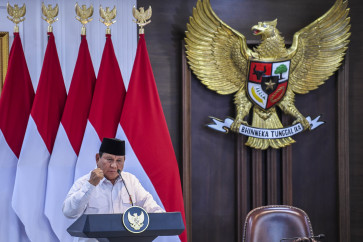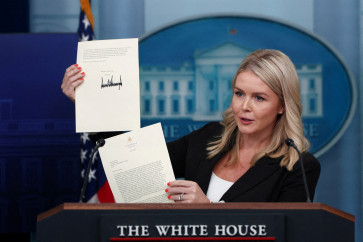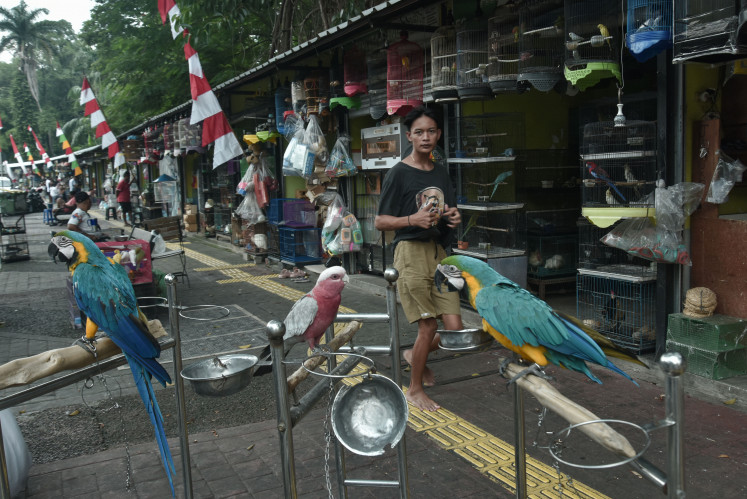Popular Reads
Top Results
Can't find what you're looking for?
View all search resultsPopular Reads
Top Results
Can't find what you're looking for?
View all search resultsKING UDAYANA - A Balinese Masterpiece
Birth of Udayana (left) and learning with a master (right)A fantastic new work by Padangtegal-Ubud artist Ketut Budiana is bringing Balinese painting to new heights
Change text size
Gift Premium Articles
to Anyone
Birth of Udayana (left) and learning with a master (right)
A fantastic new work by Padangtegal-Ubud artist Ketut Budiana is bringing Balinese painting to new heights.
More than once I have been worried about the future of “Balinese painting” —meaning painting that is technically and stylistically linked to Balinese tradition.
I feared that this type of painting, more and more aimed at the tourist market, was bound to repeat the same iconic stories, using the same chiaroscuro wash techniques.
But I was wrong. Commissioned by Udayana University in Denpasar, a new work by artist Ketut Budiana tells the story of the Balinese king to whom the university owes its name.
After a short exhibition at Bentara Budaya in Denpasar, on now until April 24, the piece will be set on the higher walls of the main hall at the university’s rectorate in Jimbaran, where it will be open to the public.

Heading to marriage
This work is a novelty in that it restores the primacy of the Balinese in the definition of their art.
Indeed, for almost a century, the evolution of Balinese art has been determined by outsiders: Dutch colonials, foreign artists and tourists.
The Balinese adapted their art accordingly. The result was Pita Maha and the encounter with modernity, with peculiar technical and thematic inputs (such as depictions of daily life and the use of ink and color) but the loss of cultural sovereignty.
Now, through Udayana University, the Balinese are back in charge, and what do they want? To convey a story, that of King Udayana, and through this story, to expose their own philosophical approach to life.
Indeed, it is not simply the story of a king that Ketut Budiana is telling. He “talks” of Udayana’s birth in Bali, his education in Java and his bringing together, through his son Airlangga, of the kingdoms of Bali and Java.
But his depiction of the king’s life story is also a “model” through which he explains how the Hindu Balinese ought to manage the four catur purusa artha (goals of human life): dharma (virtue), kama (desire), artha (earthly goods) and moksa (ultimate emancipation).
Humans must properly balance their pursuit of these “goals” along the four stages of life: the brahmacari (youth) stage should be dedicated to knowledge, the grhasta (adult) life should be dedicated to “wealth” and “desire” to enable reproduction of human life, the wanaprasta stage should see a slow withdrawal from earthly bonds and the bhiksuka stage should lead one to moksa.

Ketut Budiana
Ketut Budiana’s work contains another philosophical idea as well, that gets laid out as if to occupy the four directions of the compass, with their respective gods, and respective color nuances.
By doing this, his work symbolizes the links between one’s life and the cosmos, or God.
The 66-year-old artist is no newcomer to the art world. His “fantastic art” pieces — often spooky — centered on Balinese philosophy have earned him numerous awards and taken him to important exhibitions abroad.
He is arguably Ubud’s last great maestro. His artistic language is not purely Balinese though. It shows a very good, and spontaneous, knowledge of anatomic representation.
But instead of being narrowly descriptive, it limits itself to the minimum that is needed for narrative purposes. It is in his play with shadows he best displays his Balinese artistry.
Upon seeing this work, one wants more. In response to this request, the artist tells us he will soon be working on another “giant” work — one revolving around the notion of cosmic energy in its infinite manifestations, an idea at the core of Hindu-Balinese philosophy.
Let us all rejoice: Bali is still able to offer us, from the depth of its soul, an artistic masterpiece. Bravo Bali, and bravo Ketut Budiana.
— Photos courtesy of Ketut Budiana










